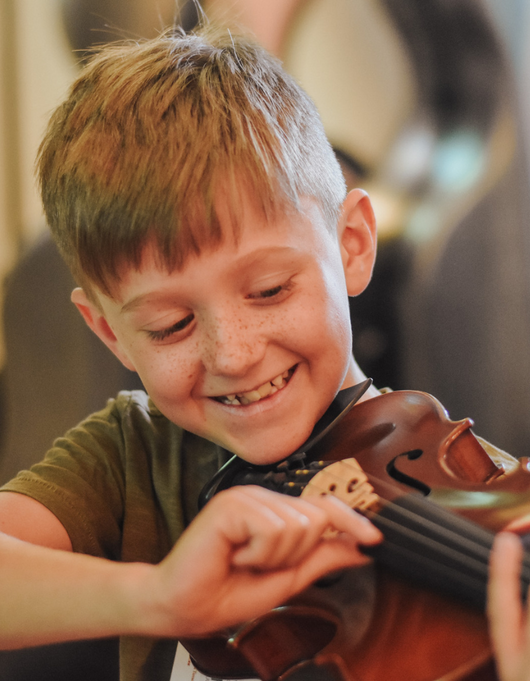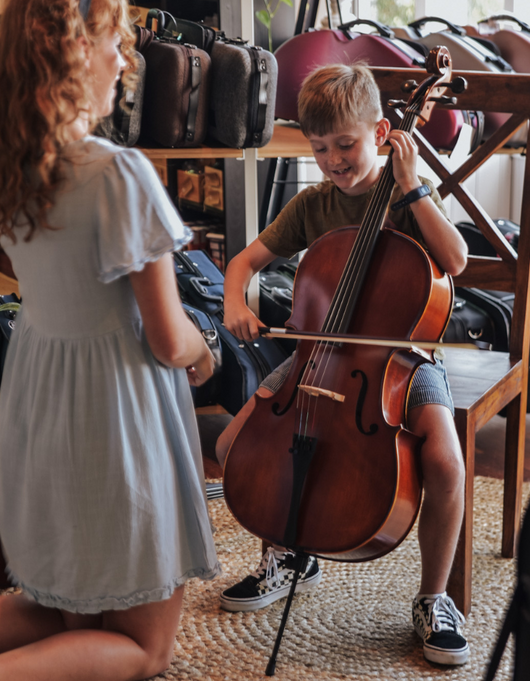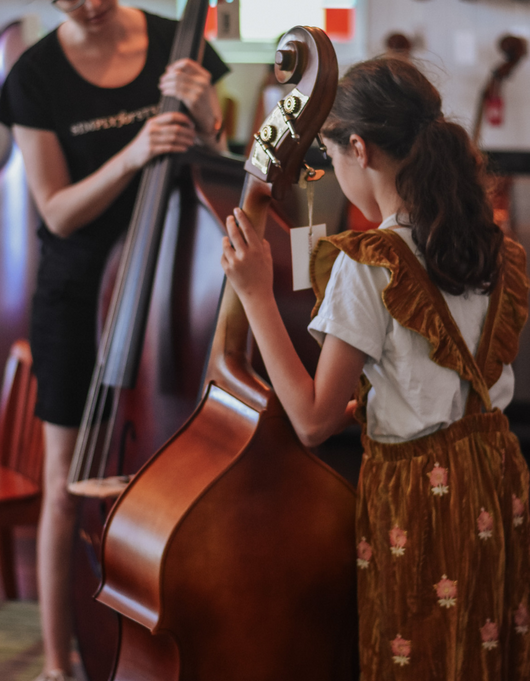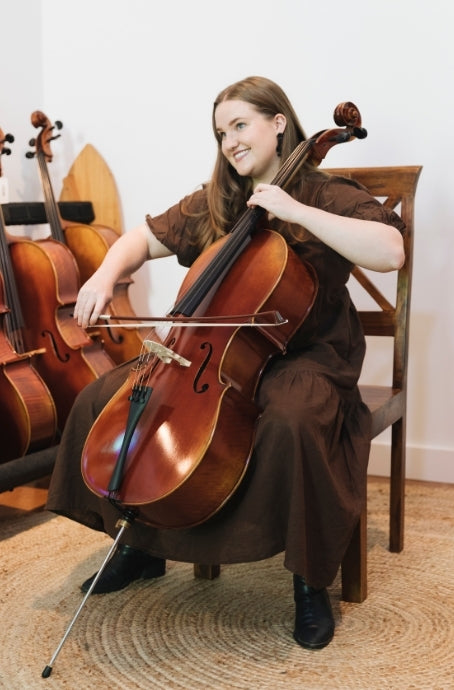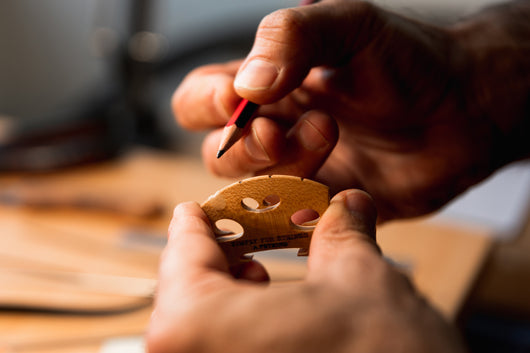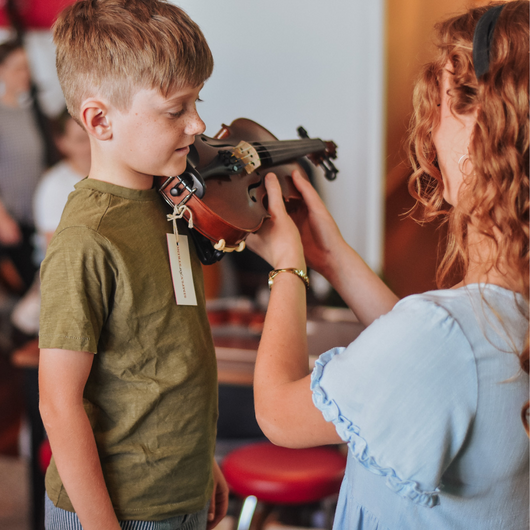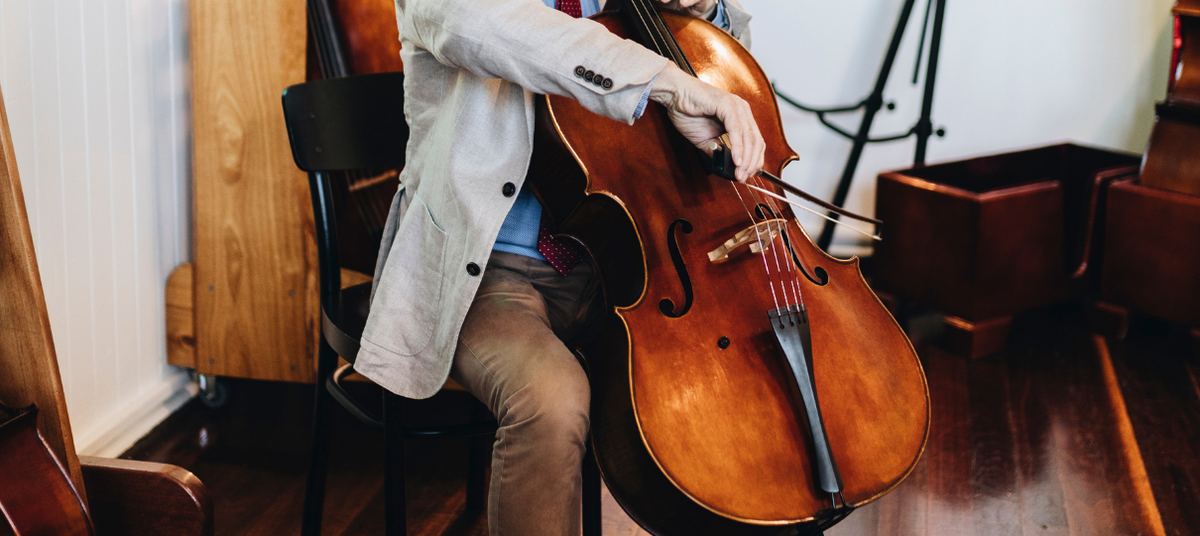We know that children are given smaller cellos, violins, violas or basses. Right (or wrong) size affects posture, which in turn affects their technique. Why not do the same for adults? This blog post is going to answer some frequently asked questions about 7/8th cellos, including how to choose the correct size for an adult, why pick a 7/8th instead of a 4/4/full size cello, how small is too small, the difference in the sound and more!
The question ‘what size cello do I need’ is something we hear quite often at Simply for Strings! Many adults come to music later in life, and may not know whether they need a 3/4 or a full size (4/4). But what some beginners may not know, is that cellos are also crafted in a 7/8th size. Stringed instruments are made in different sizes because not all people are the same.
A little background from Michael, Simply for Strings’ resident cellist, teacher and passionate customer service manager:
“The year I turned 13, on my teacher’s advice I was given my first full-size cello. I was so proud of it. It supported my musical growth very nicely for the next 5 years until my last teacher advised us to upgrade prior to leaving school, studying cello at college and pursuing my musical career. As a young professional I found certain aspects of my technique very difficult and although it didn’t stop me working and teaching, I was always a little frustrated with how hard I found some specific passages of music when others seemed to breeze through them.
Around three decades later I left my teaching job to work in a music store and guess what I discovered? There is a wonderful array of smaller options I’d never encountered. Another decade passed and I took the plunge down to a seven-eighth size cello. My hand is so much happier and I can actually master some of those pesky passages that previously eluded me …
As a teacher it didn’t even cross my mind to suggest smaller players might need a smaller cello. In line with the general approach of most teachers, when they reached high school we moved them to full size.”
How to find the correct size cello
How do we decide the correct size for someone? There are four main factors we need to consider:
- Body height. Does the cello fit in terms of body height? At 172cm, you could easily cope with a 4/4 cello, but if you have short fingers, it may be difficult to reach certain positions comfortably. Whereas somebody who is 155cm will always struggle with full size.
- Body shape. Remember that we have to grip the cello lightly with our knees/calves and lean it comfortably against the chest, with the scroll just behind our right ear. Sometimes we might choose a different size OR different body design: Strad is slimmer, Montagnana is wider.
- Arm length. Maybe your body can cope with a certain size, but if your arms are shorter perhaps the next size down would help. Remember, at some stage, you will be playing the full length of the fingerboard, and need to be able to maintain correct handshape and elbow position.
- Hand size/finger length. This is the most important factor by far. If your fingers can’t fairly naturally fall into reasonably good semitones in first position, then you will struggle in much of your playing. You need to be able to play in extended position, and to keep good handshape in thumb position. After years of playing on a cello that's too large for you, you could injure your hands and develop RSI or similar. This is definitely what we try to avoid.
So as you can see, you may simply choose a 7/8th to maintain comfort whilst playing.
There are so many things to consider when you’re starting a new musical instrument, whether it’s the cello or the violin! It can feel a little overwhelming - what age is best to start, what accessories do I need, will I even enjoy this? We’re here to make the start of your musical journey a little easier - we know exactly how you’re feeling and it’s our pleasure to share our advice with you. This guide is perfect for parents or adult learners themselves. Read more about learning the cello.
How small is too small?
If you’re an adult, we’d recommend selecting the largest possible size that is most comfortable for you. Unless you’re particularly short, chances are you’ll be looking at a 3/4, 7/8 or 4/4 cello.
What is it like to learn the violin, viola, cello or double bass as an adult beginner? It can feel a bit like going back to primary school or kindy, but if you can push through, the rewards will be endless! Read more about learning an instrument as an adult.
What’s the sound difference between 7/8 and 4/4?
Choosing a smaller instrument will reduce the sound ever so slightly, but it doesn’t have to be a problem. Plenty of young children reach a very high standard while still playing on 1/4, 1/2 and 3/4 cellos, completing all the exam grades and even progressing to the diploma levels. For this reason, there are also plenty of smaller cellos made to meet the quality requirements associated.
Finding the Perfect 7/8 and 3/4 size cellos
Most adults with smaller hands will require a 7/8 cello, or sometimes a ¾. Here at Simply for Strings, we offer four excellent models worth considering, across a broad price range.
Virtuoso Cello Outfit
Our Virtuoso Cello is an intermediate level instrument. It is a little wider and deeper than the standard Strad design adapted for most student instruments and therefore has a bigger sound and a little more richness of tone. Stepping “down” to a smaller instrument can be quite rewarding with this cello option in 4/4, 7/8, 3/4, 1/2 and ¼, as they produce a bigger sound and rich tone across all registers in all sizes, even a 1/4!
Concerto Cello
The Concerto Cello is an excellent choice for the advancing student or hobbyist. It has a large, clear and sonorous tone with beautifully shaded rich varnish. It is a lovely, antique-looking instrument with a very good quality tone that punches above its weight for its price.
Jay Haide L’Anciennce Cellos
The Jay Haide L’Ancienne is a range that really stands out. In full size, we offer various designs, all at the same price point, including Stradivari, Ruggieri and Montagnana.
Stradivari is the slimmest, with a bright and powerful sound; Ruggieri is a little larger with a stronger, fuller sound; Montagnana is fatter and shorter, giving a rich and “bassy” tone which is quite pleasing. Michael owns and plays the Jay Haide Montagnana 7/8 cello. In a 7/8, we offer the Jay Haide Montagnana model (because it is our team favourite!) and can special order 7/8 Stradivari models.
Jay Haide a l'Ancienne cellos can be ordered in these sizes: 1/2, 3/4, 7/8 and 4/4. This model cello suits many advanced cellists, including tertiary students and professionals. There are other makers in our product range who produce great cellos in smaller sizes, eg Scott Cao, KG Instruments and Gliga, so if you would like to discuss other smaller cello options please contact us.

Avoiding injury or pain whilst playing
The question of pain is an interesting one. Here’s some thoughts from Michael:
“I’ve spent much of the last decade consulting frequently with an excellent musculoskeletal doctor because of various issues associated with being a cellist and enthusiastic young man who didn’t always lift things within his limits (or do it correctly!) despite warnings from those who were older and wiser. Now that I'm getting older I have developed a keen interest in understanding how my body works when I play the cello.
There have been times when adult learners have visited our shop, or we’ve met at one of our trade displays, and conversation has found its way to the pain in their hands, shoulders or back. When I have then tried them on our cellos we have found two big factors which seem to contribute to the problem: posture, especially relating to shoulder and elbow positioning; and cello size, which first affects our ability to form the ideal hand shape and position when playing, and second, affects our posture and compounds the whole thing! Finding the most appropriate size can be a lifesaver indeed.
In a couple of cases these lovely, eager cellists have developed something similar to “trigger finger” or “trigger thumb”. Their cellos were full-size and they had ended up in so much pain they had stopped playing for long periods of time. We have looked at posture, changed to smaller cellos, given some appropriate hand exercises, and in one case sent our friend to see a good hand O.T.; and now they are happily playing again with much better results. One of these two ladies moved to 7/8 and the other now has a 3/4 cello. Finding the right size, and working with posture/technique, made all the difference. And once upon a time I, like most other cello teachers, would have continued to inflict 4/4 pain on them until they eventually gave up because just looking at a cello would induce a nasty sensation …”
We hope this blog post has answered your questions! If you have any more questions for our friendly team, get in touch with us via video call or email today.

